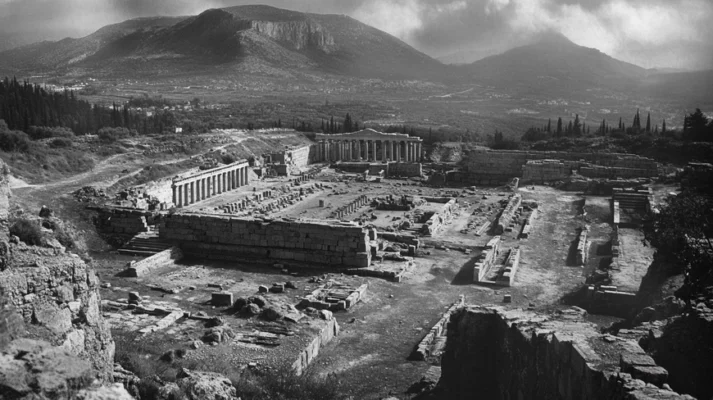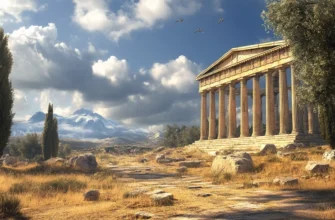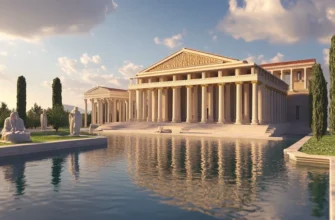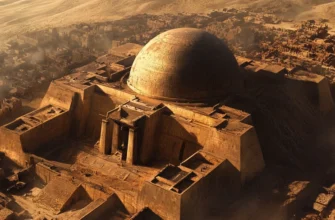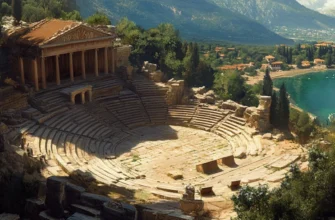Zakros is an ancient city on the island of Crete, which was an important center of the Minoan civilization. It is located in the southeast of the island, near the modern village of Kato Zakros. The city is particularly valuable for its well-preserved archaeological remains, including the famous Palace of Zakros.
The palace in Zakros was the fourth most important after Knossos, Phaistos, and Mallia. Its construction dates back to approximately 1900–1450 BC. The complex had a ramified structure with rooms for storage, living, rituals, and administrative management. Its proximity to the sea indicates active trade with the eastern regions of the Mediterranean.
The city fell into decline around 1450 BC, probably due to an earthquake or volcanic eruption on Santorini. Zakros left an important legacy that provides a deeper understanding of the life, culture, and religion of the Minoans.
Today, the ruins of the city and palace attract tourists and researchers, and Zakros is considered one of the key archaeological sites of ancient Crete.
Zakros is located on the southeastern coast of the island of Crete, in the Lasithi region. The ancient city is located near the modern village of Kato Zakros, about 40 km east of the city of Sitia. The area is characterized by its mountainous terrain and proximity to the coast, which made Zakros a convenient port for trade with Egypt, Syria, and other regions of the Eastern Mediterranean.
In addition to the sea coast, the Zakros Gorge is located nearby, known as the “Valley of the Dead” due to the numerous burials found in the caves of its rocks. This geographical location provided not only trade links but also natural protection for the city.
Historical significance of Zakros
Zakros was of great importance during the heyday of the Minoan civilization (around 2000–1450 BC). Thanks to its favourable location on the east coast of Crete, it became an important trading port through which sea routes to the Middle East, Egypt and Cyprus passed. This made Zakros a strategic hub for the exchange of goods, cultural heritage and technology.
The central feature of the city was the Palace of Zakros, an administrative and religious center where goods were stored, records were kept in Linear A script, and religious ceremonies were held. Unlike other Minoan palaces, the palace at Zakros remained relatively intact because it was not looted after its decline.
Zacharo is also an important source of knowledge for archaeologists and historians. Many of the objects found there — frescoes, ceramics, seals, and other artifacts — provide insight into the high level of development, art, and religion of the Minoan culture.
Archaeological research
Archaeological research in Zakros began in the 20th century and was a real breakthrough in the study of the Minoan civilization. The first explorations in the region were carried out by British archaeologist David Hoggart in 1901, but the most significant discoveries were made by Greek archaeologist Nikolaos Platon in 1961. It was he who excavated the almost completely preserved Palace of Zakros, the fourth most important palace in Crete after Knossos, Phaistos, and Malia.
During the excavations, archaeologists discovered more than 150 rooms, including temples, warehouses, archives, and residential areas. Numerous household items, cult figurines, tableware, and tablets with inscriptions in Linear A, one of the oldest writing systems in Europe, were found.
Of particular value are the finds in the tombs of the Zakros Gorge (“Valley of the Dead”), where burials with priceless jewelry, weapons, and religious symbols have been preserved. The absence of looting has made these artifacts extremely important for scientific analysis.
Thanks to its well-preserved layers, Zakros has become a unique source of information about the life, beliefs, and social organization of the Minoans. It continues to be the subject of research and restoration, opening new pages in the history of ancient Crete.
Main archaeologists and stages of research
Archaeological research at Zakros spans over a century and has been carried out in several stages, involving prominent scholars who have made significant contributions to the study of the Minoan civilization.
- Initial research (early 20th century)
In 1901, British archaeologist David Hoggart, a representative of the British Archaeological School in Athens, conducted the first excavations in the Kato Zakros area. He discovered the remains of Minoan structures and speculated about the existence of an important settlement. However, due to a lack of funding, the research was not continued.
- The great discovery (1961)
In 1961, Nikolaos Platon, a Greek archaeologist, resumed research in Zakros.
It was he who discovered the fourth Minoan palace, the best preserved of all those found on Crete. Platon systematized the excavations, cleared numerous halls and rooms, and discovered cult and household objects, as well as warehouses with remnants of imported goods.
- Further research (1970–2000s)
After Plato’s death, other Greek archaeologists continued the work in collaboration with international expeditions. They focused on:
studying the tombs in the “Valley of the Dead”
analyzing tablets with Linear A script
preserving the buildings of the palace complex
- The modern stage (2000s–present)
Modern researchers use the latest methods, including:
georadar scanning
3D modeling
DNA analysis of burials
The work is coordinated by the Greek Ministry of Culture. Zakros has become not only an archaeological site but also a scientific testing ground for studying the past of Minoan civilization.
Architectural monuments
The architectural monuments of Zakros, especially its palace complex, are a unique source of knowledge about the structure, layout, and functioning of the cities of the Minoan civilization. Thanks to its good preservation, Zakros is often called a “time capsule” of Minoan architecture.
The Palace of Zakros
The main architectural monument is the Palace of Zakros, built around 1600–1450 BC. The palace had over 150 rooms and was centered around a central courtyard. Its structure included:
Ceremonial halls — intended for religious ceremonies and receptions.
Storage rooms — where amphorae with oil, wine, and goods were kept.
Private quarters — for the elite or the ruler.
Storage tablets and archives — with examples of Linear A writing.
Complex water supply and sewage systems — typical of Minoan engineering.
Unique finds, such as stone rhytons, faience statuettes of goddesses, and imported tableware, testify to the cultural and religious wealth of the palace.
Residential buildings and streets
Outside the palace were residential neighborhoods where the city’s population lived. The streets were narrow, paved with stone, and had drainage systems. The houses had two or three floors and consisted of living and utility rooms.
Tombs in the “Valley of the Dead”
Numerous burial caves have been found in the rocks near the gorge, where the inhabitants of the city buried their dead. Many of the tombs contained valuable items, indicating a developed religion and social hierarchy.
The architecture of Zakros demonstrates the high level of organization, engineering, and aesthetics of the Minoan era.
Culture and everyday life
The inhabitants of Zakros belonged to the advanced Minoan civilization, which was famous for its art, crafts, religion, and high level of social organization. Archaeological finds indicate that the culture and daily life of the city were closely linked to maritime trade, religious rituals, and art.
Daily life of the inhabitants
The inhabitants of Zakros were engaged in:
trade (especially with Egypt, the Levant, and Cyprus),
agriculture (growing wheat, barley, olives, and grapes),
crafts such as pottery, jewelry making, weaving, and tool making.
Houses were spacious, often with two floors, kitchens, storerooms, and inner courtyards. Remains of pottery, spindles, and stone tools indicate that women were engaged in housework and weaving, while men may have been traders or craftsmen.
Religion and rituals
The Minoan religion played an important role in Zakros. Numerous cult figurines, rhytons (sacred vessels), and shrines have been found in the palace itself. The main figure of worship was the Mother Goddess, who was often depicted with snakes or doves.
Religious rituals and sacrifices were probably accompanied by music and dancing. The caves in the “Valley of the Dead” were also used for funeral ceremonies.
Art and symbolism
Zakros, like other cities of Minoan civilization, was distinguished by its bright aesthetics and decorativeness. The following items have been found here:
frescoes with marine motifs,
ornamented pottery,
jewelry made of gold, silver, and semi-precious stones.
The symbolism of the double axe (labrys) was important and can be found on both ritual objects and walls.
The culture of Zakros was sophisticated, spiritually rich, and connected to both nature and the sea.
Trade and connections with other cities
Zakros was one of the most important trading centers of the Minoan civilization, playing a key role in Crete’s connections with the eastern Mediterranean. Its location on the southeastern coast of the island provided easy access to sea routes to Egypt, Syria, Asia Minor, and Cyprus.
Foreign trade
The following goods were imported to Minoan Crete through the port of Zakros:
exotic goods: ivory, lapis lazuli, raw materials for jewelry making;
metals: copper and tin, necessary for the production of bronze;
luxury items: amphorae with perfumes, jewelry, fabrics.
In return, the Minoans exported:
olive oil,
wine,
ceramics (especially with characteristic marine ornaments),
handicrafts.
Finds of amphorae with foreign markings, as well as fragments of Egyptian scarabs and Cypriot ceramics, confirm the wide geographical range of Zakros’ trade contacts.
Connections with other cities of Crete
Zakros had close ties with other Minoan centers, primarily with:
Knossos, the administrative center of the island;
Phaistos and Mallia, palace cities with a similar architectural model;
Palaikastro, a trading city in northeastern Crete.
The exchange of information, cult objects, and administrative technologies (such as Linear A writing) contributed to the unity of the Minoan cultural space.
Zakros not only received goods but was also a transshipment point in the large Minoan trade network, which united parts of three continents — Europe, Asia, and Africa.
Decline of the city
Zacharos, like many other Minoan settlements, experienced a period of decline in the mid-15th century BC. This process was part of the broader decline of the Minoan civilization, which occurred around 1450 BC. However, the decline of Zacharos can be attributed to several possible factors:
- Natural disasters
One of the main reasons for the city’s decline is believed to be a natural disaster, specifically an earthquake or volcanic eruption on Santorini (Thira). The volcanic eruption, which occurred around 1600 BC, was one of the largest in history, and its effects could have caused destruction in coastal cities such as Zakros. The eruption could have damaged ports, disrupting trade routes and affecting the economy.
- Internal conflicts and invasions
Another possible factor in the decline is internal political instability or invasion by external enemies. For example, there is speculation that the invasion of the Mycenaeans (ancestors of the classical Greeks) from mainland Greece may have led to the destruction of the Minoan settlements. Although there is no direct evidence of war, archaeological finds indicate the destruction and burning of buildings at the end of the 15th century BC.
- Economic difficulties
Zachoros was an important trading center, and any changes in trade routes or the economic situation could have had a devastating effect. The decline of maritime trade, the loss of access to important resources, or an internal economic crisis could be considered as another factor contributing to the city’s decline.
- Changes in social structure
The Minoan civilization underwent serious social and cultural changes at the end of its existence. The decline of religious practices, changes in political structures, and the reduction of centralized power may have contributed to the city’s decline.
Like many other Minoan cities, Zakros was left in ruins after its decline, and although its palace and many buildings have been preserved, the city was never restored to its former glory.
The decline of the city left a deep mark on the history of Crete, as it became part of the general process of the collapse of the Minoan civilization, which paved the way for a new era — the era of the Mycenaeans and Classical Greece.
Zakros today
Today, Zakros is one of the key archaeological sites on the island of Crete and an important tourist attraction. The ruins of the ancient city attract thousands of tourists from all over the world, as well as archaeologists and researchers who continue to study the remains of this magnificent civilization.
Zacharo Archaeological Park
Today, an archaeological park open to visitors is located on the site of the ancient city. It includes:
The Palace of Zacharo, one of the best-preserved Minoan palaces, where you can see an extensive system of rooms, staircases, and inner courtyards.
The tombs in the Valley of the Dead, where the burials of the ancient inhabitants of the city have been preserved, along with numerous household items and religious artifacts.
Storage rooms and remains of civil buildings, which give an idea of the life and economy of the city.
Infrastructure and research
Modern research and restoration of monuments are actively supported by the Greek government and international archaeological organizations. They include the use of the latest technologies, such as 3D modeling, ground-penetrating radar surveys, and fresco restoration.
Due to the popularity of the site, a tourist infrastructure is developing near Zakros, including hotels, restaurants, and tours that allow visitors to not only explore the ruins but also learn more about the city’s history through interactive exhibitions and special events.
Cultural significance
Zakros is also an important part of Greece’s cultural heritage. Thanks to the discoveries made at this site, scientists have been able to significantly deepen their knowledge of the Minoan civilization, one of the oldest and most influential cultures in Europe. The city is a symbol of the development of ancient Crete, which influenced the culture and art of Europe as a whole.
Like many other Minoan sites, Zakros remains an important place for scientific research and is also an important site for the preservation and promotion of ancient Greek heritage.
Conclusion
Zakros is one of the most important archaeological sites of ancient Crete, reflecting the rise and fall of the Minoan civilization. This city not only attests to the high level of development of Minoan culture, but also provides invaluable information about the daily life, religious practices, and trade relations of that time. Thanks to archaeological excavations, including a well-preserved palace, as well as burials and religious objects, we can imagine what the social and economic structure of the city looked like. Zakros is also an excellent example of the architectural heritage of Minoan civilization.
Its palace system, storage rooms, residential quarters, and religious buildings leave a lasting impression of Minoan urban planning and art. The city played an important role in the trade network that connected Egypt, the Middle East, and the Mediterranean islands, facilitating the exchange of goods and cultural achievements.
Despite its demise in the mid-15th century BC, Zakros has left us not only artifacts and ruins, but also a deep understanding of the importance of this city for the development of European civilization. Today, it is part of the world’s cultural heritage, and research continues, opening new pages of ancient history.
The historical heritage of Zakros embodies the greatness of the Minoan civilization and continues to inspire archaeologists and history enthusiasts to make new discoveries, deepening our understanding of the past.
